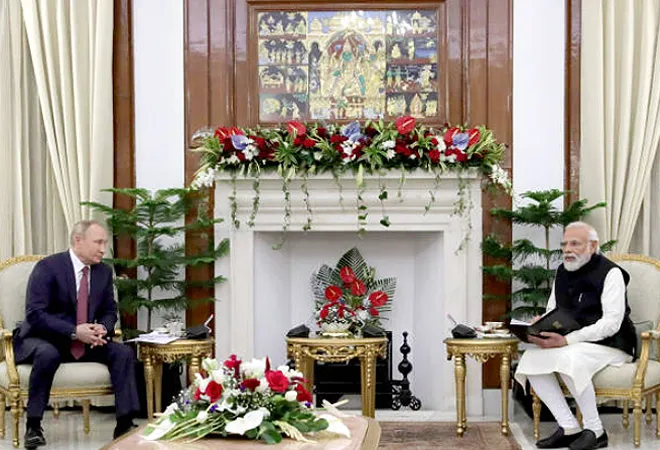
Modern international relations, like those of earlier centuries, are still heavily influenced by the human component, or, to use a historical expression, the function of a person in history. Russia and India are now headed by persons who have achieved worldwide prominence and are regarded as capable politicians. Chemistry, of course, contributes to the advancement of bilateral ties. Furthermore, neorealism's structural theory tells us that structural elements, such as the reality rather than the created alignment of powers in the globe, are the most significant in international relations.
Relations through prism of IR theory
India, which has existed as an independent state on the global political map since 1947, has achieved remarkable success over the years, rising to become a world-class power and the world's third largest economy. India's prominence and role are constantly increasing, and its impact may be seen across South and Central Asia, as well as the Near and Middle East. Furthermore, some scientists consider India to be one of the world's few superpowers. Russia, on the other hand, is a well-established military force with a strategic culture, as well as military and diplomatic traditions. The naked eye can still see Moscow's influence and position in the post-Soviet space, the Near and Middle East, and Asia. Despite economic and demographic challenges, Russia maintains an important role in international affairs.
Neorealism's structural theory tells us that structural elements, such as the reality rather than the created alignment of powers in the globe, are the most significant in international relations.
However, despite their prominence, they are still not full-fledged superpowers, which can only be referred to the United States and China; but they are nonetheless, quite near to this mark, which has tremendous implications for international relations. There is reason to suppose that the regional superpowers' position is improving at this point. Given the coming clash between the United States (US) and China on many fronts, a few people will eventually have to bear the full brunt of this conflict, which neither India nor Russia appears to be able to escape from. In the future decades, the conflict between Beijing and Washington will remain at the core of international politics, and it will bear a significant cost as a result. Some other major nations may be granted a reprieve, which might be utilised to invest in growth and modernisation.
The historic independence of Russia and India in foreign policy, which is uncommon in the current transit and system of international relations that is bursting at the seams, lends special significance to the ties. The loss of independence in one of the nations’ foreign policy may be the least likely reason in lowering the degree of confidence. However, based on the two nations’ current development paths, this is unlikely to happen in the near future. We are dealing with rather powerful actors in international affairs, and it is impossible to allow them to become dependent on today's superpowers. Furthermore, regardless of the scenarios and dimensions of the US-China confrontation, Russian-Indian ties can become a force that stabilises Eurasia and, potentially, the international relations system as a whole.
India-Russia ties: A background
Russian-Indian contacts date back to the 17th century, and over the years, we have witnessed how these relations have magnified. The USSR and India established diplomatic ties in 1947. Over 250 bilateral treaties were signed between the new Russia and India following the fall and dissolution of the USSR, out of which, The Friendship and Cooperation Treaty, signed on January 28, 1993,and the Declaration on the India-Russia Strategic Partnership, signed during President Vladimir Putin's state visit to India in October 2000, serve as cornerstones of the partnership. Bilateral interactions can be described as strategic partnerships, and later observers began to use the term privileged to this situation.
Regardless of the scenarios and dimensions of the US-China confrontation, Russian-Indian ties can become a force that stabilises Eurasia and, potentially, the international relations system as a whole.
As a result, the relationship between these actors is robust and based on mutual natural interest and cooperation.. The partnership is built on a firm equitable basis. In such circumstances, no one feels deprived and the collaboration is not seen as a burden. Ordinarily, cooperation has a manufactured, rather than a natural, aspect. Proponents of the IR theory, structural realism, place a premium on these concepts and factors. Because of the framework of the modern world, the partnership is self-sufficient. If we were to consider two different nations, with different peoples, cultures, political systems, and histories, under normal circumstances they would still want collaboration from the standpoint of international relations framework. This is the essence of structural design. A large number of international players are frequently required to establish fake social constructs that serve as the foundation for expanding interactions, forming strategic collaborations, and forming intimate relationships. Moscow and New Delhi, on the other hand, do not require this as its relations is bolstered by a degree of intimacy and chemistry amongst the leaders.
Cooperation in different areas
President Vladimir Putin has only made a few international trips in the past. Furthermore, the parties announced the formation of the 2+2 framework, which entails tight and ongoing coordination between the defense and foreign ministers of the two nations. From the combined battle against the worldwide pandemic to economic cooperation and military-technical collaboration, Russian-Indian ties are high-level and yet have room for progress. As a result, the parties decided to manufacture Sputnik V vaccines on Indian soil, which has official recognition amongst other things. In addition, India is one of the rare countries tot have two national vaccinations at the same time: Covishield and Covaxin.
Economic and trade cooperation has also expanded over the years; however, it is still far from the real potential. The trade turnover fluctuates around US $10 billion per year. India has the capacity and will to become a major investor in the Russian economy of the Far East. The visit of Prime Minister Narendra Modi to Vladivostok, Russia, in 2019 served as the beginning for the registration of a new Indian strategy, “Act in the Far East”, where priority is given to trade interregional cooperation. Recently, the Gujarat Provincial government sent invitations to the governors of the Russian Far East to participate in the Vibrant Gujarat Investor Summit in 2022. We emphasise that this western province is Prime Minister Modi's birthplace and plays an important role in the Indian economy. The parties are working to enhance the Vladivostok-Chennai maritime corridor by undertaking North-South infrastructure projects and initiatives. By 2025, the goal is to raise trade and investment cooperation to US $30 billion. The regional superpowers also signed major energy contracts. Russia will supply oil to India, which will deepen bilateral relations and strengthen both sides.
In an interview with Russian media, Russian Ambassador to India Nikolay Kudashev also stated that, despite the general economic downturn in 2020, the Far Eastern Federal District's foreign trade turnover with India increased by more than 5 percent to US $764 million, and the regions of Russia's Arctic zone increased trade turnover with Indian partners by 12.6 percent to US $800 million. Rosneft, Gazpromneft, and Sibur, for example, have a number of projects with Indian partners.
A large number of international players are frequently required to establish fake social constructs that serve as the foundation for expanding interactions, forming strategic collaborations, and forming intimate relationships.
Military-technical cooperation is likely to be one of the most important topics in bilateral discussions. “It would not be an exaggeration to claim that 60-70 percent of the equipment of the Indian army is of Soviet and Russian provenance,” the Russian Ambassador to India said. According to independent specialists, nearly 80 percent of the Indian Navy is supplied with Russian weaponry, while the Air Force is equipped to the tune of 70 percent. According to experts, Russia has reportedly sent more than US $65 billion in military weapons to India in recent years. The nations are coordinating the legal manufacturing of AK203 assault rifles, according to The Diplomat. According to Russian state media, Russia and India are working on a number of bilateral projects, including the BrahMos complexes, the cooperative development of a fifth-generation fighter, and licensed aircraft and tank production. On 6 December, Indian Defense Minister Rajnath Singh stated on Twitter that India has signed multiple small weapons and military cooperation agreements, contracts, and protocols. In addition, before the end of the year, India will get the first division of S-400 systems.
Afghanistan and counterterrorism
Defence, counterterrorism, and the Afghan dossier are all hot topics in bilateral relations at the moment. The two nations' presidents decided to establish a permanent consultation mechanism between India and Russia in the summer of 2021, which would be led by National Security Advisors Nikolai Patrushev and Ajit Doval. India formally participated in the Moscow format on Afghanistan, according to the Russian ambassador. Nikolai Patrushev, the Secretary of the Security Council, also took part in the Delhi security debate. In the Afghan problem, both sides highlight that the countries are united by their relatively close approaches.
Russia has reportedly sent more than US $65 billion in military weapons to India in recent years.
Afghanistan's problems should be examined in greater depth. For a variety of reasons, India can claim leadership in South Asia. Its economic, demographic, and military characteristics much outweigh those of its neighbours. As a result, New Delhi's strategists cannot afford to ignore the happenings in Afghanistan. After the Taliban movement's triumph on 15 August, 2021—the movement is banned by the Russian Federation—Afghanistan, for India, shifted from a field of opportunities to a field of potential threats. The friendly, predictable dictatorship, however inefficient, reliant on foreign forces, and corrupt, was replaced by a hostile radical movement that utilised terrorism as a political tool. As a result, India has become sensitive to developments in Afghanistan, as well as the dynamics of the new Kabul's political trajectory. Concerns have been raised about the development of Pakistan’s role in Afghan politics. The Taliban movement was formed, financed, and protected by the Pakistani military, which is generally documented in the scholarly literature and has never been hidden. Given the two nations’ antagonism and the Kashmir issue, India's concerns have grown even more evident and justified, speaking in the language of international affairs.
Observers who feel the Taliban is incapable of regular and effective government and fixing Afghanistan's problems support this view. The Taliban appear to be divided in their aims and behaviour. Several groups within the movement are at odds with one another. Perhaps, the most palatable scenario is one in which relative modernists and moderates triumph against followers of the ultra-radicals of the Haqqani Network, who are fully reliant on Rawalpindi. At the same time, practically all major powers underline the need for the Taliban to forsake terrorism as a tool of political struggle, break ties with al-Qaeda, and form an inclusive government.
India has become sensitive to developments in Afghanistan, as well as the dynamics of the new Kabul's political trajectory.
India's role in South Asia resembles Russia's unique status in the post-Soviet area. As a result, from the standpoint of structural neorealism, India, as a regional leader, may claim to have its unique voice heard in the context of the Afghan crisis.
As a result, collaboration on the Afghan issue has emerged as one of the most important aspects of Russia-India relations. The Taliban's control is a reality in modern Afghanistan. The radical movement appears to have a chance to stay in power, at least for the time being. From the standpoint of international terrorism, this situation is disruptive. The Taliban's triumph serves as a business model, incentive, and example for terrorist organisations throughout the world as well as sympathetic participants in international affairs. We must, nevertheless, continue to deal with Afghanistan. For all serious players in international life, broad collaboration in this interaction is required. Many nations, including Russia, the United States, China, India, Iran, Pakistan, Uzbekistan, Central Asian countries, and the European Union, require an exchange of views and the capacity to comprehend each other's stances on the Afghan problem. The UN mechanisms have the potential to play a helpful role in this situation.
The views expressed above belong to the author(s). ORF research and analyses now available on Telegram! Click here to access our curated content — blogs, longforms and interviews.




 PREV
PREV


